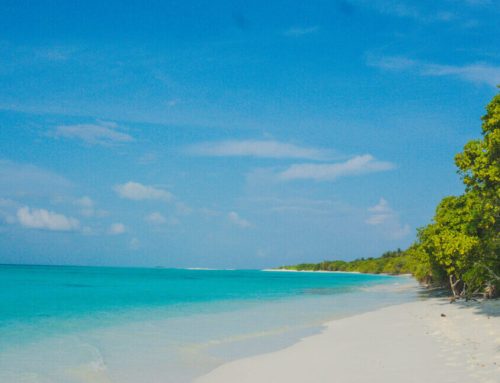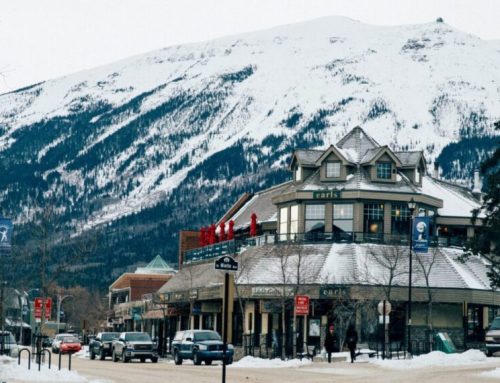Destination Stewardship Report – Spring 2022 (Volume 2, Issue 4)
This post is from the Destination Stewardship Report (Spring 2022, Volume 2, Issue 4), an e-quarterly publication that provides practical information and insights useful to anyone whose work or interests involve improving destination stewardship in a post-pandemic world.
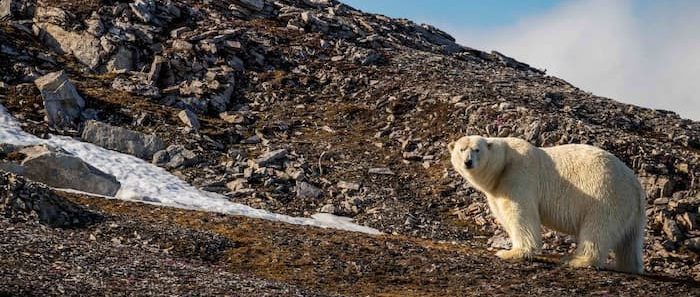
Its camouflage useless, a polar bear treads snowless terrain in Svalbard. Photo: Marcus Westberg
Svalbard Overheating
With its coal mines now closing, Norway’s polar archipelago of Svalbard faces a unique set of threats: disrupted tourism, rising temperatures, and increased international vying for arctic control. Yet its extreme location also provides a unique set of opportunities for reviving tourism, according to this Communiqué from Arild Molstad.
Breaking News from the Island of the Polar Bears
The inhabitants of Spitsbergen – all two thousand of them – don’t have to pore over the United Nations’ climate change reports to feel that something’s not right.
On the only populated island in the Svalbard archipelago, a mere 90 minutes’ flight from the North Pole, bursts of rain are beginning to appear in February. Tourists who fly from distant continents to the “capital” of Longyearbyen to explore the majestic mountains on snowmobile under the Northern Lights may instead find themselves back in their hotel rooms, waiting for colder weather, watching sled-drivers return their frustrated howling huskies to camp. Midwinter rain is bad news all around in Spitsbergen: For dogs’ paws caught in slippery tracks; for reindeer trying to scratch their way through frozen surfaces to forage for edible moss and lichen; for surprised tour operators caught out by inaccessible slushy terrain.
Rising Temperatures
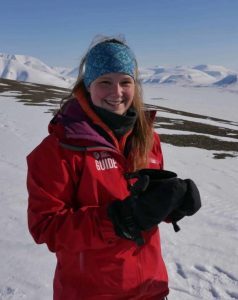
Svalbard tour guide trainee. Photo: Arild Molstad
“This ain’t supposed to be happening,” sighs a tour guide, downing a pint of foamy Mack’s Beer in a popular bar, where some of his old drinking buddies are nowhere to be seen. As coal mining is being shut down permanently, their sooty, grimy, exhausted faces remain only as black and white photo portraits on the wall, mementos from a colorful history now fading away. Some of the gritty facades that once gave Longyearbyen its one-company-town atmosphere have yielded to erosion- and avalanche-proof housing.
The melting of Svalbard is not happening in a hurry. For decades the archipelago will remain a bucket-list destination for travellers looking for adventure, remoteness, and the spectacular, unforgettable beauty of the black granite mountains topped by glittering ice, their glaciers sloping towards fjords and valleys like bridal veils.
But the metrics are scary. The archipelago is the fastest-melting place on earth: Since 1971 the temperature has risen by 4 degrees Celsius, five times higher than the world average. In winter the increase is 7 degrees. An astounding +22°C was recorded last summer.
Which means that ecotourism, which in the last decades was seen as Svalbard’s sure-fire alternative to a doomed coal mining industry, is facing an uncertain future. This comes at a time when this distant destination has been struggling with a post-pandemic decline in visitors, who even prior to 2019 didn’t stay long, most of them cruise passengers doing short day excursions.
Tourism Goes Greener
That is why Ronny Brunvoll is burning the midnight oil these days. As the leader of Visit Svalbard, he is in charge of an expert team updating the Svalbard Tourism Master Plan. It is important work, fraught with challenges, many of them political. The 1920 Svalbard Treaty was based on compromises between eight nations, one of them a weakened Russia in the aftermath of WWII.
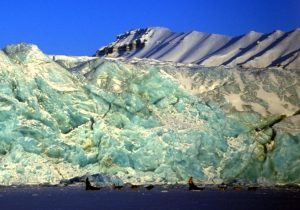
Dog sledders pass beneath a shrinking glacier. Photo: Arild Molstad
The treaty conferred sovereignty upon Norway, but declared the archipelago a visa-free zone, meaning anybody willing to work is welcome. Local laws are dictated by the arctic weather, safety, and environmental concerns. Now, against the background of rapid climate change and – until the pandemic struck – growing tourism, Norway’s government in Oslo is prescribing a strict regimen that curbs visitors’ movement anywhere on the islands.
Above all, that regimen will hit cruise tourism hardest, imposing a ceiling on the number of passengers per vessel. No final decision has been made yet, but the limit will likely be set to between 200 and 500 passengers, effectively putting a stop to conventional, polluting large-cruise-ship traffic. What will be allowed: expedition-class motor vessels. But even they will face strict rules as to where and when they can organize shore excursions.
“We must find ways to keep them here longer,” says Mr. Brunvoll , who is conscious not only of the per capita CO2 emissions burned during the long journey from the mainland by ship or plane, but of the need to find employment for Norwegian citizens. One way to do so is making it compulsory to hire locally trained guides who are familiar with the terrain – and armed for protection against polar bears looking for food scraps as their traditional habitat is threatened by shrinking ice. No ice means no place from which bears can catch seals. “The bears are easier to spot now,” a wildlife guide told me. “But remember, they’ll spot you long before you see them.”
Global Safety Vaults as Attractions
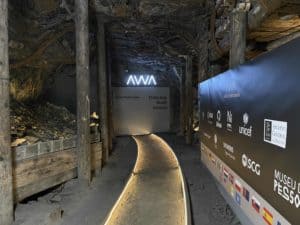
The Arctic World Archive is built into the permafrost. Photo: Copyright AWA
The tourism challenge is a delicate balancing act. Recently, more visitors have been drawn to Spitsbergen’s Global Seed Vault – a repository of seeds from mostly developing nations, should they face a famine, natural catastrophe or acts of war. Nearby another vault has recently been dug into the permafrost – the Arctic World Archive. Here nations’ institutions are depositing rare, invaluable artifacts, data, documents, and art, digitalized on tape guaranteed to last for 1,000 years.
Now there is talk about building a visitor center to welcome visitors to both vaults. If that happens, it would likely be an attraction that could prolong the average tourist’s stay. The center would function as a drawing card for narrating the colorful, exciting story of Svalbard, from the early 17th century arrival of fearless trappers and fisher folk to the transformation into a tight-knit community, situated in a place once considered remote, but now caught in the middle of a modern version of the colonial powers’ “Great Game.” Today ambitious nations are jockeying for position and access to oil and gas, precious minerals and huge fish stocks, as the Arctic Sea soon will become ice-free.
About Arild Molstad
Author, photojournalist, conservationist, consultant www.arildmolstad.com


